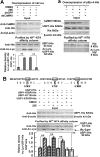The steroid hormone 20-hydroxyecdysone via nongenomic pathway activates Ca2+/calmodulin-dependent protein kinase II to regulate gene expression
- PMID: 25670853
- PMCID: PMC4375498
- DOI: 10.1074/jbc.M114.622696
The steroid hormone 20-hydroxyecdysone via nongenomic pathway activates Ca2+/calmodulin-dependent protein kinase II to regulate gene expression
Abstract
The steroid hormone 20-hydroxyecdysone (20E) triggers calcium signaling pathway to regulate 20E response gene expression, but the mechanism underlying this process remains unclear. We propose that the 20E-induced phosphorylation of Ca(2+)/calmodulin-dependent protein kinase II (CaMKII) serves an important function in 20E response gene transcription in the lepidopteran insect Helicoverpa armigera. CaMKII showed increased expression and phosphorylation during metamorphosis. 20E elevated CaMKII phosphorylation. However, the G protein-coupled receptor (GPCR) and ryanodine receptor inhibitor suramin, the phospholipase C inhibitor U73122, and the inositol 1,4,5-triphosphate receptor inhibitor xestospongin C suppressed 20E-induced CaMKII phosphorylation. Two ecdysone-responsible GPCRs and Gαq protein were involved in 20E-induced CaMKII phosphorylation by RNA interference analysis. 20E regulated CaMKII threonine phosphorylation at amino acid 290, thereby inducing CaMKII nuclear translocation. CaMKII knockdown by dsCaMKII injection into the larvae prevented the occurrence of larval-pupal transition and suppressed 20E response gene expression. CaMKII phosphorylation and nuclear translocation maintained USP1 lysine acetylation at amino acid 303 by inducing histone deacetylase 3 phosphorylation and nuclear export. The lysine acetylation of USP1 was necessary for the interaction of USP1 with EcRB1 and their binding to the ecdysone response element. Results suggest that 20E (via GPCR activation and calcium signaling) activates CaMKII phosphorylation and nuclear translocation, which regulate USP1 lysine acetylation to form an EcRB1-USP1 complex for 20E response gene transcription.
Keywords: 20-Hydroxyecdysone; Ca2+/Calmodulin-dependent Protein Kinase II (CaMKII); Histone Deacetylase 3 (HDAC3); Phosphorylation; Steroid Hormone; Transcription Regulation; USP1 Lysine Acetylation.
© 2015 by The American Society for Biochemistry and Molecular Biology, Inc.
Figures








Similar articles
-
G protein-coupled receptors function as cell membrane receptors for the steroid hormone 20-hydroxyecdysone.Cell Commun Signal. 2020 Sep 9;18(1):146. doi: 10.1186/s12964-020-00620-y. Cell Commun Signal. 2020. PMID: 32907599 Free PMC article. Review.
-
Protein kinase C delta phosphorylates ecdysone receptor B1 to promote gene expression and apoptosis under 20-hydroxyecdysone regulation.Proc Natl Acad Sci U S A. 2017 Aug 22;114(34):E7121-E7130. doi: 10.1073/pnas.1704999114. Epub 2017 Aug 8. Proc Natl Acad Sci U S A. 2017. PMID: 28790182 Free PMC article.
-
Phospholipase Cγ1 connects the cell membrane pathway to the nuclear receptor pathway in insect steroid hormone signaling.J Biol Chem. 2014 May 9;289(19):13026-41. doi: 10.1074/jbc.M113.547018. Epub 2014 Apr 1. J Biol Chem. 2014. PMID: 24692553 Free PMC article.
-
In a nongenomic action, steroid hormone 20-hydroxyecdysone induces phosphorylation of cyclin-dependent kinase 10 to promote gene transcription.Endocrinology. 2014 May;155(5):1738-50. doi: 10.1210/en.2013-2020. Epub 2014 Feb 11. Endocrinology. 2014. PMID: 24517229
-
Structural Insights into the Regulation of Ca2+/Calmodulin-Dependent Protein Kinase II (CaMKII).Cold Spring Harb Perspect Biol. 2020 Jun 1;12(6):a035147. doi: 10.1101/cshperspect.a035147. Cold Spring Harb Perspect Biol. 2020. PMID: 31653643 Free PMC article. Review.
Cited by
-
Anticipatory UPR Activation: A Protective Pathway and Target in Cancer.Trends Endocrinol Metab. 2016 Oct;27(10):731-741. doi: 10.1016/j.tem.2016.06.002. Epub 2016 Jun 25. Trends Endocrinol Metab. 2016. PMID: 27354311 Free PMC article. Review.
-
The steroid hormone 20-hydroxyecdysone induces phosphorylation and aggregation of stromal interacting molecule 1 for store-operated calcium entry.J Biol Chem. 2019 Oct 11;294(41):14922-14936. doi: 10.1074/jbc.RA119.008484. Epub 2019 Aug 14. J Biol Chem. 2019. PMID: 31413111 Free PMC article.
-
G protein-coupled receptors function as cell membrane receptors for the steroid hormone 20-hydroxyecdysone.Cell Commun Signal. 2020 Sep 9;18(1):146. doi: 10.1186/s12964-020-00620-y. Cell Commun Signal. 2020. PMID: 32907599 Free PMC article. Review.
-
The steroid hormone 20-hydroxyecdysone binds to dopamine receptor to repress lepidopteran insect feeding and promote pupation.PLoS Genet. 2019 Aug 14;15(8):e1008331. doi: 10.1371/journal.pgen.1008331. eCollection 2019 Aug. PLoS Genet. 2019. PMID: 31412019 Free PMC article.
-
Restoration of energy homeostasis under oxidative stress: Duo synergistic AMPK pathways regulating arginine kinases.PLoS Genet. 2023 Aug 3;19(8):e1010843. doi: 10.1371/journal.pgen.1010843. eCollection 2023 Aug. PLoS Genet. 2023. PMID: 37535699 Free PMC article.
References
-
- Thompson E. B. (1995) Steroid hormones: membrane transporters of steroid hormones. Curr. Biol. 5, 730–732 - PubMed
-
- Sandén C., Broselid S., Cornmark L., Andersson K., Daszkiewicz-Nilsson J., Mårtensson U. E., Olde B., Leeb-Lundberg L. M. (2011) G protein-coupled estrogen receptor 1/G protein-coupled receptor 30 localizes in the plasma membrane and traffics intracellularly on cytokeratin intermediate filaments. Mol. Pharmacol. 79, 400–410 - PubMed
-
- Falkenstein E., Tillmann H. C., Christ M., Feuring M., Wehling M. (2000) Multiple actions of steroid hormones: a focus on rapid, nongenomic effects. Pharmacol. Rev. 52, 513–556 - PubMed
-
- Davis P. J., Tillmann H. C., Davis F. B., Wehling M. (2002) Comparison of the mechanisms of nongenomic actions of thyroid hormone and steroid hormones. J. Endocrinol. Invest. 25, 377–388 - PubMed
Publication types
MeSH terms
Substances
Associated data
- Actions
- Actions
LinkOut - more resources
Full Text Sources
Miscellaneous

